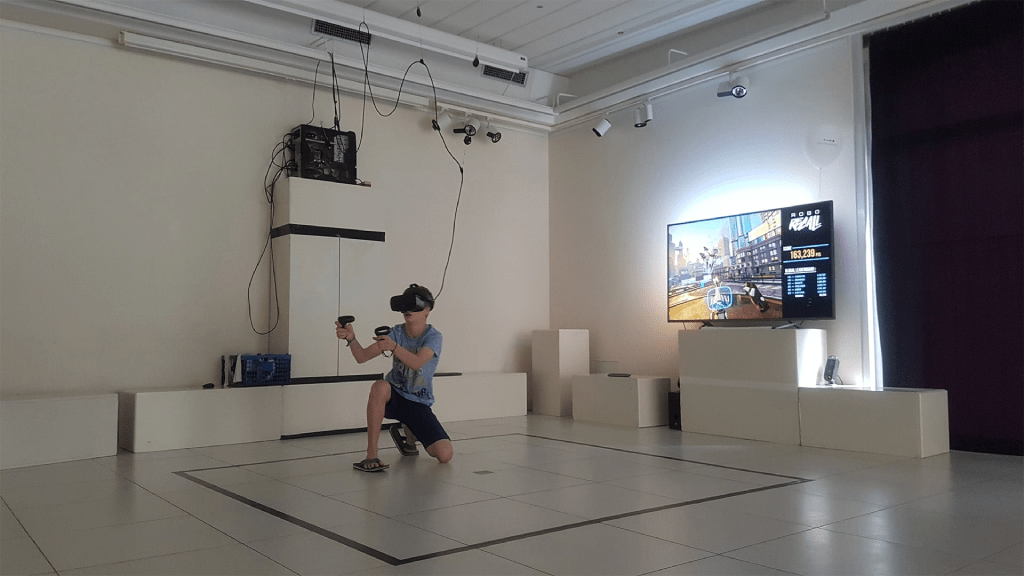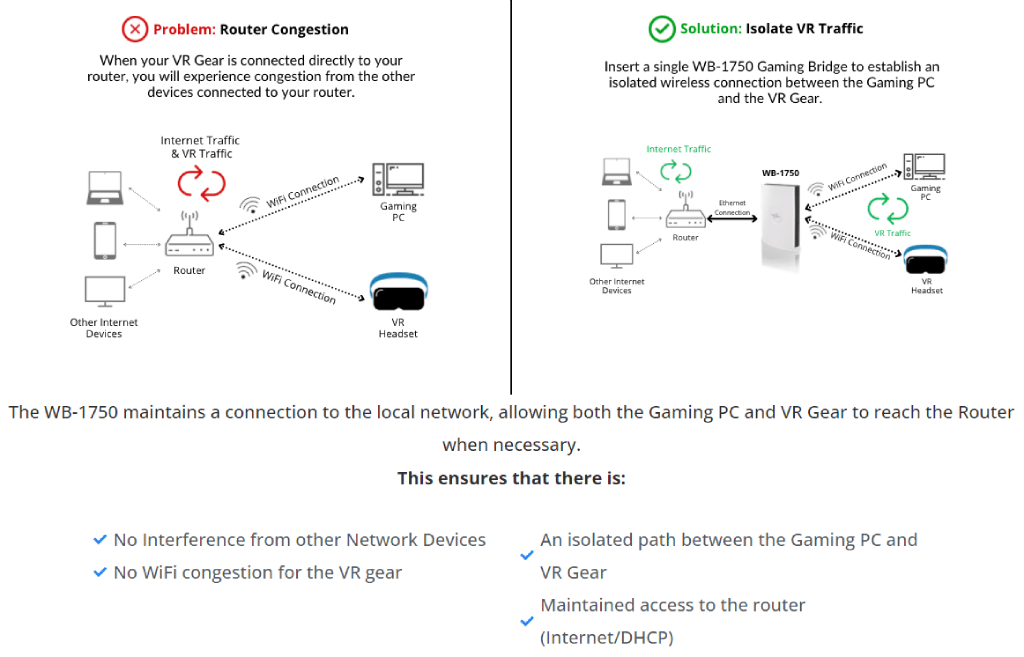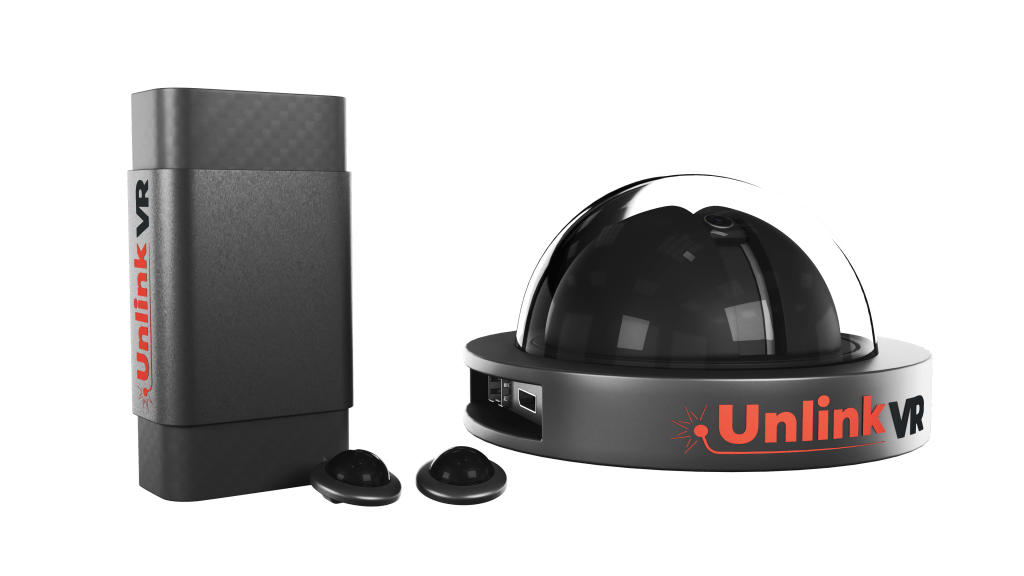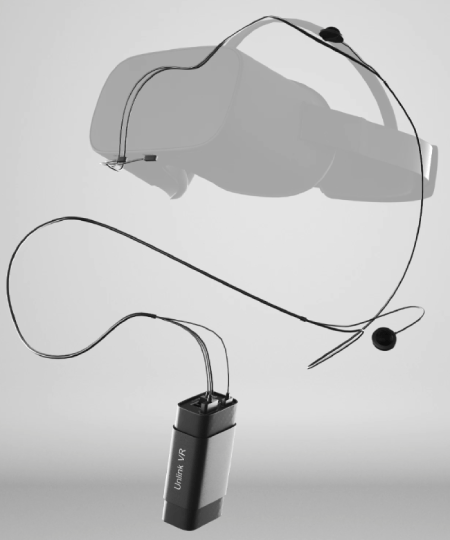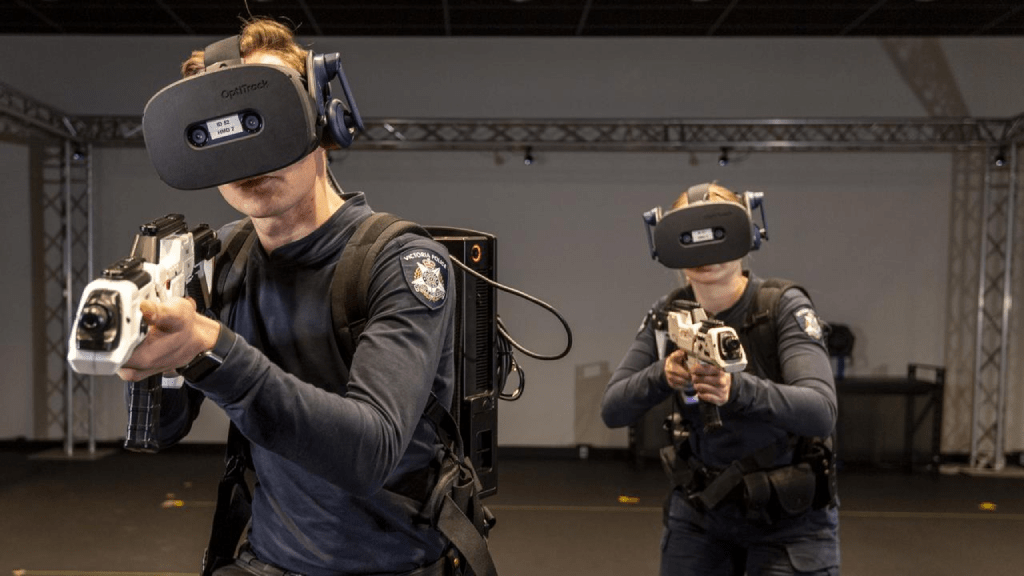Wireless VR is about to get a whole lot better
CES saw some interesting developments this year, particularly so on the VR front. From various haptic suits and gloves to the ridiculous 'smell-o-vision' type contraption, there was a whole host of intriguing tech on show. For me though, perhaps the most fascinating, innovative, and practical prototype came from a new start-up called Unlink-VR. A team committed to totally changing the way we approach wireless VR headsets.
What makes VR so great, and what could make it even better?
When it comes to VR, there's two major appeals that elevate the platform above a console or PC experience. The first is the undeniably superior level of immersion it offers, literally placing you into the game world or simulation, and allowing you to interact with it in natural and intuitive ways.
The second is having the freedom to move around these environments - walking through tranquil scenes, ducking under fallen trees, crouching over containers, dodging bullets, peaking around corners, or even crawling behind cover to evade detection. Besides contributing to that increased level of immersion, being able to actually move around the virtual world is a feeling quite unlike any other, and depending on the game or simulation in question, it can certainly keep you pretty active too. However, historically, this ability to move around in a virtual world has come with one major drawback - it's never been true freedom of movement.
For many years, VR headsets were what we might refer to as an HMD (Head Mounted Display), meaning they couldn't run the games themselves, but rather they came with cables that wired you into a powerful VR ready gaming PC. That meant that even in rooms with plenty of space to prance about, you were never be able to go beyond that 5m cable tethering you to the hardware powering the headset. Sure, it was possible to extend the cable, but you would have been sacrificing a seamless VR experience by introducing significantly more latency and reducing the overall fidelity. What's more, as many familiar with PCVR will know, you would almost certainly find yourself caught up in that cable at some point or another too. The best solution to which was limited to true enthusiasts, those willing to invest in finnicky pulley systems that helped keep the cable off the floor and out of the way.
Of course, in more recent years, the arrival of the Oculus Quest and Quest 2 have brought us significantly closer to achieving that true freedom of wireless VR, with no cables needed thanks to its powerful onboard hardware, and no sensors or Base Stations needed courtesy of some phenomenally good 'inside-out tracking.' As far as standalone VR headsets go, they're fantastic, with an incredibly low barrier to entry both in terms of cost and user-friendliness.
But once again, this step towards wireless VR came with its own drawbacks. Besides the controversial requirement for a Facebook account, which was introduced when Oculus was acquired by the aforementioned back in 2014, the main limitation of the new wireless format was of course the hardware.
Limitations of a wireless VR headset
Ultimately a VR headset needs to be as light as possible, and cool too, which means using efficient mobile hardware. As amusing as it would be to see an RTX 3090 strapped to an 8-year-old's face, it would obviously be completely impractical. As such, you won't be playing any super demanding PCVR titles on the Quests, or at least not at particularly high settings or framerates. Even using the experimental Air Link feature (which allows you to stream games running on a PC to the headset) isn't good enough for a seamless VR experience - it's simply too reliant on having good, stable, uninterrupted WiFi. As such, even if you were able to get a serviceable connection, though 'playable,' the experience would be nowhere near as good or as enjoyable as it really could be.
At the end of the day, radio waves are still somewhat limited when it comes to transmitting data. Primarily, the limitations for WiFi are most obvious in the form of its bandwidth capabilities and the rate at which it can transfer data, which, besides already being significantly less than a wired connection, gets exponentially worse with every additional connected device. In modern homes, the likelihood of having a dedicated router specially for some good wireless VR fun is next-to-none, whilst the likelihood of having upwards of 12 devices all vying for bandwidth is almost guaranteed.
Even if a few years down the line we can resolve the bandwidth and data rate limitations, that doesn't detract from the fact that radio waves are fairly easy to interrupt. From your next-door neighbour's own home network, to Bluetooth devices, microwaves, and any kind of physical obstructions like walls and furniture; they can all disrupt the signal between your router and the device you're trying to stream data to.
There's also the matter of range and coverage as well. Although it may not be a particularly big deal in homes and small offices, it's not at all ideal once you start to scale things up. In other words, if you ever wanted to have some sort of wireless VR set-up either in a large indoor space, or outside, it simply wouldn't be viable.
But that's where Unlink-VR comes in with a potentially revolutionary idea. What if you could overcome the latency and fidelity loss of existing wireless options, whilst increasing the data rate and range of transmission almost tenfold? Well, as it turns out, you can. By using infrared lasers.
Lasers could be the answer
According to the guys working on this wonderfully Sci-fi project, using lasers could well be the future of wireless VR. And the best part is it could work with any kind of headset, wired or wireless in theory.
Besides opting to create an HMD agnostic product which will work out-of-the-box with no driver support needed, the way Unlink-VR's system works is by mounting small receivers (about the size of a thimble) to the top of the headset strap, with one or two others located somewhere on the body. These are then connected by USB ports to the headset via a small hub, which also acts as a battery pack to power everything at the user's end.
Meanwhile, a transmitter connected to the PC uses a rather clever tracking system to continually follow the nearest unobstructed receiver, and can even make use of small mirrors placed around a room to find a new line-of-sight (LoS), should the beam ever become interrupted.
The end result is a system capable of offering everything that technologies like the Quest's Air Link could only ever dream of - a holy matrimony between the freedom of wireless VR, with the power, fidelity, and reliability of a wired connection.
For example, a headset like the Varjo Aero - one of the highest resolution headsets currently available on the market - would be almost impossible to use running on contemporary mobile hardware, limiting it to a wired connection. But thanks to the system on offer here, you'd be able to experience the wonders of VR at the highest possible fidelity, whilst simultaneously having the freedom to move however you want. Imagine being able to play something like Half Life: Alyx, possibly one of the greatest VR titles available today, with not only the graphics maxed out, but also able to fully appreciate them, as well as having no cables to hold you back. It would be insane!
This could go a lot further in theory too. With some more conceptualising and development, a system using lasers could lead to VR being viable on a massive scale, and outdoors too. Just imagine again for a moment: you could set up in a huge open field with a headset, a PC, the Unlink-VR system, and a couple of drones. The PC does all the heavy lifting by running the games, and that data is transmitted via a laser to one of two or three drones floating around, thirty meters overhead. Those drones have both a receiver and transmitter, allowing them to then relay the data to someone in the field wearing the VR headset, where they blissfully enjoy hacking and slashing in Blade and Sorcery, able to literally run a hundred meters in any direction to chase down their foes.
Granted, it's not something we'd necessarily see any time soon, and having 100m2 to play a videogame in would be somewhat overkill. But it's certainly possible, and the implications for other areas using the VR medium, such as the Defence and Public Service sectors, is undeniably attractive.
Wireless VR for Simulation
VR as a means of training has started to make its way into Law Enforcement Agencies, for example, where agents can be trained for highly stressful and dangerous scenarios such as hostage situations or active shootings, but all within a 'Safe-to-Fail' virtual environment. In instances like these, having high-end, high-fidelity headsets like the Varjo Aero are a must; training can last several ours and long periods spent looking at a lower resolution display would be guaranteed to cause eye-strain and headaches for even the most well-adjusted users. Plus, with additional critical features like automatic IPD adjustment and active head cooling, an existing wireless solution like the Quest 2 simply can't compete. Naturally then, these training programmes, by the very nature of contemporary VR solutions, means being limited to large indoor spaces, where the use of either cumbersome back-packs or intricate pulley systems are needed in order to emulate a wireless experience. Throw the wonders of a system like Unlink-VR into the mix though, and well, that's a game changer.
Simultaneously bypassing the need for mobile hardware and cable tethering really is the key here, as it opens up other avenues for improvement with HMDs. Take form factor: most modern HMDs are somewhat bulky and heavy. Even the Quest 2, which is likely one of the smallest and most lightweight headsets on the market, would still give you neck ache after long enough, and keeping it securely on your face will usually leave behind some rather impressive red marks when you later remove it. But we've seen some new concept HMDs crop up over the last few years (including this year at CES), which seek to completely scale down the traditionally large HMD designs we're so used to seeing.
Previously, this wouldn't have garnered much interest from myself, as these super small and compact headsets (more like glasses in some instances) suffer from the exact same problems that headsets like the Quests do: they're limited by the hardware. Though they may have been intended more for AR purposes, or ultra-casual VR games (akin to how the mobile gaming market compares to the PC gaming scene), with the addition of a system like Unlink-VR, there's now colossal potential - a future where you could well be wearing a pair of goggles that do nothing more than stream everything from a powerful PC via lasers.
Some disadvantages of the Unlink-VR solution
So, with all the amazing possibilities that Unlink-VR presents to the industry, are there any real downsides? The answer of course, is yes.
The most obvious issue with lasers is that, unlike a cable or radio waves, the connection is entirely reliant on line-of-sight. The moment the transmitter loses sight of a receiver the connection is gone in an instant. That said, by having multiple receivers and using mirrors to account for potential blind spots, Unlink-VR have got a comprehensive set-up that would prove hard to fault, even if you were trying. Attempting to cover 3 receivers situated on both your body and head from multiple different angles would be a hell of a challenge.
But in the event that you did achieve this, or perhaps a more likely scenario where you only have a single receiver, now the onus is on Unlink-VR's tracking system. From demo videos I've seen of the prototype transmitter, although it seems to cope well with smaller adjustments to LoS, if it gets particularly 'off track' from a receiver, it can take quite some time to re-find it. It is a prototype though, and these demos were using a single receiver set-up at very close range, which could be what's affecting the tracker's ability to adjust. So, something to bear in mind.
Another issue at present is that there is no way to send data from the user back to the hardware running the application, using the same system. Fortunately though, data being sent to and from the PC is asymmetrical, and so sending data to the PC does not require the same speed or bandwidth as receiving data from it. Currently this means making use of existing technologies (i.e. WiFi) to cover this pitfall, though in the long run Unlink-VR will be working on a more custom solution, as existing options limit the update rate of the lasers. Which is undesirable to say the least.
Of course, the other problem present here is that neither Unlink-VR's lasers or WiFi can record positional tracking to send to the PC. That means in its current state, the system will still need sensors or Base Stations of some kind, both of which will still need to be wired into the PC. I'm not yet sure what Unlink-VR's solution to this will be, if any, though I can't help but wonder whether there might be some way to use additional lasers. I know for a fact that Valve's Steam VR Base Stations already use lasers to 'sweep' an environment looking for 'photonic sensors' located on the Valve Index and its accompanying controllers. So perhaps there's something they might investigate there.
Lastly, another major drawback is that the product looks like it could be quite pricey. Although there's no pricing to be found on their website, nor any indication from anyone working on the project what sort of cost a system like this would carry with it, I did manage to find some possible figures courtesy of a site called StartupNetwork. I've not previously heard of it myself, but it seems to be pretty legit, and Unlink-VR have a page on the Ukrainian version of the website listing their project in fairly good detail. Under the Finance header, they state:
"We see that we will be able to sell 100K sets in 1st year. Price is about 799-999 USD. Not cheap, but average VR set (headset + PC) is about 5-7K USD. So, we believe to have 80-100M cashflow within a year from first sale."
Their logic is somewhat sound here though their numbers seem slightly off. Working on the assumption that a headset and PC constitutes a wired HMD like the Valve Index: the headset alone would set you back £1000, and a Gaming PC capable of running it to the best of its capabilities would easily sit somewhere in the £1500-£2500 range. That's still only up to £3500 though, which is a far cry from the $5000-7000 they mention on the site. Then again, if they're including all of the peripherals and a monitor in the cost, it's likely more accurate.
Either way, it's clear that if this does come to market, the cost will be pretty steep, so the system will likely start out life in the B2B market before trickling down into the consumer market. Similarly to the way Varjo's VR 3 and XR 3 eventually lead to the more consumer, albeit enthusiast focused, Varjo Aero.
Final Thoughts
Ultimately though, from a consumer standpoint, that's exactly what the Unlink-VR system is: an enthusiast solution to an enthusiast problem. For the "average" VR user, this notion of having true freedom of movement isn't really of their concern - it's no news to anyone that the Oculus Quest 2 recently became the single most purchased VR headset to date, including by Steam users. It's not hard to see why - it's a headset that's amazing out-of-the-box, can be both wired or wireless, and the hardware does a remarkably good job of running most current VR titles on the market. Meanwhile, wired HMDs currently can't ever be wireless (bar the HTC Vive with some expensive accessories that really aren't worth it), and they need you to either purchase or already own an equally expensive PC. So, why would you bother with a comparatively cumbersome headset like the Valve Index or HTC Vive?
But with that said, for the VR enthusiasts out there, these are some exciting prospects. The idea of being able to take your favourite wired HMD and use it completely wirelessly, whilst retaining the ability to run incredibly demanding PCVR titles which just wouldn't be the same on a Quest, is something a lot of VR users have been dreaming of for some time now.
What are your thoughts on Unlink-VR? Are you really excited about the future of wireless HMDs too? Or is this just a pipe dream? Let us know down in the comments!
Posted in TechShot
Published on 16 Feb 2022
Last updated on 09 Feb 2023
